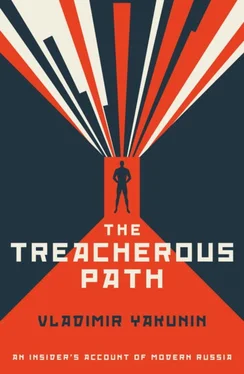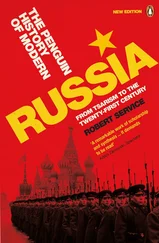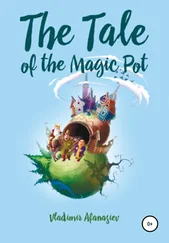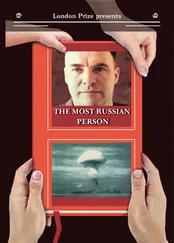This was allied with an extensive obligation to answer to the government for everything we did. Because it was part of the strategic plan of the state – and a matter in which the President took a close personal interest – it was considered essential that the government continued to oversee it. Every plan we created, every decision we wanted to make, almost every breath we took, was recorded and analysed and submitted to Moscow.
Another thing that was plain was that Russian Railways could no longer be run as one undivided entity, an approach that may have been practical thirty years previously, but which was no longer sustainable in the twenty-first century. The finances, record-keeping and inventories of all the various elements of the organisation were bundled up together, and this made it almost impossible to measure anything within the organisation, to know which elements were performing well and which needed help or intervention. So, although the parent company remained a majority shareholder, Russian Railways’ manifold functions were hived off into 150 daughter companies, each a separate, self-sufficient business with its own budget and board of directors. We were moving away from being run as a national monopoly towards creating a competitive market and ultimately, we hoped, driving up efficiency, and driving down costs.
The changes we began to implement throughout the railway system eventually allowed us to attract more than $50 billion of private investment. One of the most immediate uses to which we could put this was the renewal of our locomotives and rolling stock – over the course of ten years, we were able to plough in 16 billion roubles into this area. When I joined Russian Railways, we were purchasing forty locomotives a year, but before long that figure had risen to 800. We bought the best models available and did everything we could to increase passenger comfort both within the carriages themselves and at stations (in stark contrast to the Soviet era, where little or no attention was paid to the passengers’ welfare).
We also realised that if we purchased the majority of our assets – whether steel for tracks or the locomotives themselves – from domestic manufacturers, we would be able to play a part in stimulating industrial development in the country. We soon became involved in borrowing the most advanced technology available from abroad, or entering into partnerships with foreign firms such as Siemens and setting up everything from metallurgical plants to factories that could produce passenger wagons.
Significant as these changes were, they were also often largely invisible to the public. It was important, we believed, that people should judge the reforms we were implementing not by abstract concepts such as tonnage or profit, which would have meant nothing to them and done even less to improve their lives, but by the quality of their own individual experiences. In partnership with the local authorities, in Moscow we developed a comprehensive plan that ensured the railways that ran around the city became an essential part of the capital’s transport system. Alongside this, we built badly needed rail connections to Moscow’s major airports and did the same in a number of other Russian cities, notably Kazan.
We also created a high-speed railway from Moscow to St Petersburg: the Sapsan train. It used to be an overnight journey, but now it could be done in under four hours. While some of the first ‘Sapsan’ trains were attacked by hooligans hurling stones as they passed through remote villages – they did not realise that it was a service that they could use themselves, and saw it as another example of the modern world’s bounty passing them by – before long, families were making trips to their local railway station so they could have their photographs taken beside the brand-new trains.
The Sapsan was not Russian Railways’ only achievement during these years, but in its ability to make a tangible difference to ordinary people’s lives while also providing a spur to the local and national economies, it was an exemplar of the kind of investment-led business model that I believe is the best for Russia. If we had not adopted this approach during the first years of my time at Russian Railways, we would not have been able to undertake projects as vast and expensive as creating much of the transport infrastructure for the Sochi Olympics, building the Severomuysky Tunnel and embarking on the complete renovation of the Trans-Siberian and BAM lines.
However, by 2013 everything had changed. Russia was struggling to cope with economic problems more severe than at any point since the 2008 financial crisis, GDP growth had all but come to a halt, and the word recession was on everyone’s lips.
More troublingly, even after the symptoms were beginning to take their toll, we could not at first determine what was causing them. Ministers suggested it was due to the effects of the global slowdown, whereas a number of bankers argued that it was because big, state-funded infrastructure projects were coming to an end and private companies had not stepped in to keep spending. And we were told by Western economists that it was the result of fundamental structural weaknesses: our overreliance on oil; the overenergetic role of the state in the economy. One thing was clear, though: when a problem is difficult to diagnose, and when it proves impossible to reach any consensus on what caused it, finding a solution becomes even harder.
The situation was exacerbated later that year by the fallout from the conflict in Ukraine, which led to sanctions on longterm borrowing, and also a steep drop in the price of oil. This, combined with the lavish social subsidies and social welfare that Vladimir Putin had promised as part of his 2012 re-election campaign, forced Russia into budget revision.
We could not avoid recognising the bruising new status quo: the state no longer possessed the financial muscle to support investment-based economic growth and, more than that, the political winds had changed. Russia’s government had embraced an economic philosophy with which I had little sympathy, and which I knew would in turn be equally unfriendly towards the kind of business model I had become accustomed to following at Russian Railways.
The first blow landed on 11 September 2013, when the Minister for Economic Development, Alexey Ulyukaev, acting with the approval of the President, announced a one-year freeze on the tariffs we were able to charge companies for transporting goods. January 2014 would be the first time in fourteen years that we would be unable to raise prices in the new year. Though the tariff would be increased the following January, it would only be in line with 2014 levels of inflation.
It was a move that slashed Russian Railways’ principal source of raising money. To understand the true scale of this decision’s consequences, I feel it would be worth spending a moment explaining what tariffs are, and the place they occupy within the Russian economy.
Tariffs are prices charged for state-regulated services, which in Russia have always included what we call our natural monopolies, such as gas, electricity and the railways. They are the only serious mechanism the railway system, which has for more than a century been the sole provider of transport for freight over large parts of the country, can employ to generate income.
The level of control that our government exerts over the whole process is far in excess of what you might find in Western Europe or North America, where, because of increased internal competition and the fact that the tariffs are generally designed to cover only infrastructure costs rather than investment activity, the state is rarely, if ever, involved. The tariff system played a significant role in the Soviet Union’s planned economy, as a means of controlling prices, and even after 1991, it was still regularly used to balance or encourage economic development. This might have taken the form of promoting growth in remote parts of the country, helping industries in financial difficulty, or even providing lower tariffs to some neighbouring countries.
Читать дальше












